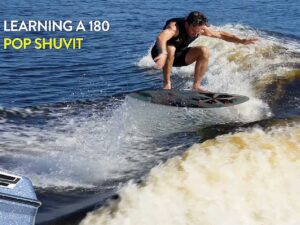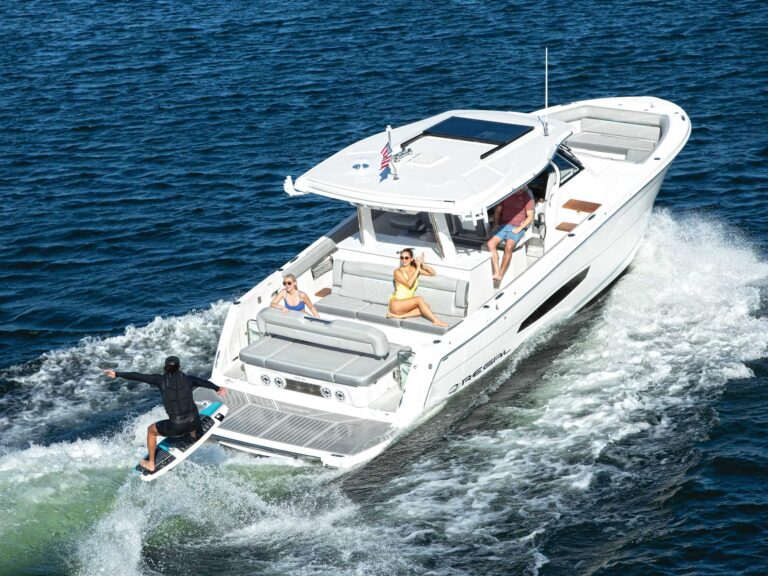I remember the first time I saw a Raley. It was probably the first time most people saw a Raley – on ESPN, in the summer of 1993. While all the other riders in the fledgling pro tour were doing rolls and rolls to revert, Darin Shapiro would dig in, cut hard, then EXPLODE through the wake. His legs thrown behind him and his arms out in front of him, he’d fly like Superman across the wakes. It was the coolest-looking move I’d ever seen on a wakeboard. But that was then. Things have changed … right?
Not really. Raleys are still some of the most impressive- looking, albeit overrated, tricks off the water. – T.J.
“There was a point when I was sketched about going upside down, but the level of
riding got such that it was do it or die.”-Greg Nelson
Raleys
Surprisingly, this is not a hard trick to do. As P.J. Marks of the Wakeboard Camp says, “It’s a hard trick to learn, but once you learn it, it’s the easiest trick there is.” Marks says you are ready to start trying Raleys when you are totally skying your jumps and landing out in the flats with perfect control every time. He says the Raley is a really easy trick; the only hard thing is mental. After years of jumping under control, it’s tough to get your brain to let you get the board out behind you and your hands out in front of you.
To learn the Raley, Marks says he gets people to cut out three-quarters of the way. “The key is to really wait to get on your edge until right in the foam. So do a really slow turn and instead of a low, squatty cut, I try to get people to push the board out in front of them. The distance between your board and your butt should be as far as you can make it.” In other words, lock your legs out on the cut. This gives you more leverage to kick out higher.
People think they need to cut super-hard and super-fast. You don’t. What you want to do is load the line through the wake and then back off your edge just a little bit by standing up and letting the handle up. This causes the board to snap over your head. You’ll still be on your edge, but the motion from cutting hard to letting off a little does the work. When the wake kicks you, your board will swing behind you and you’ll be doing a Raley.
Charley Patterson of O-Town Watersports gives the same tips but in a different way. Patterson also says you should have a good strong progressive edge, and he stresses edging up and through the entire wake. He says it is critical that you are as tall as possible with your hips up on your approach. He cautions not to drop your butt to edging like on a normal cut because it takes away from your height. Then you should keep the rope close to your hips as you come off the top. In your approach, your weight is on your heels. Don’t transfer your weight to your toes until you are completely in the air. Also, wait until you are in the air to let your arms up.
Both instructors say the only thing you should be worried about is the cut. Naturally you should keep your head up looking at the boat, but the whole trick is done at the cut. You shouldn’t have to do anything in the air if you do it right. Marks also adds that you shouldn’t have to bring it back down. When you go off the wake, your body hyper-extends and snaps behind you. Then, when your body reaches the limits of its flexibility, your back automatically snaps the board back down. The more you let your arms out, the easier it is to get the board back under you. Patterson says to be sure to keep your eyes on the shore or the boat, and when the board starts to come down, bend your elbows and pull the rope to your hips.
Although this is a move you pretty much have too commit to, you can build up to it by shortening the line and trying it at first at a slower speed. You also might want to put on a wetsuit and a vest for more body protection.
Krypts
The most obvious and first variation you’ll want to try after you have your Raleys wired is a krypt. This is just a Raley to fakie. Don’t think you can do a star-gazing Raley (nose will fly away from the boat) and call it a krypt. That’s not stylish. Keep the board nice and even behind you, and then bring it to fakie. So, do everything the same as for a normal Raley, but on the way down release your front hand and pull the rope to your rear hip. Keep your eyes on the shore on the way down. If you try to turn your board to fakie too early, your board will star-gaze and it’ll be hard to get the board back under you. So get all the way to the top, and on the way down push the handle into your side.
Hoochie Glides and Orientals
Although these look pretty much like Raleys, they are not. They are crosses between a normal wake jump and a Raley. For a hoochie glide (Raley with heelside grab) or oriental (Raley with toeside grab), you don’t edge up and through the wake. This is a totally different cut. Do more of a squatted-down cut nowhere near as hard as a Raley. Start about halfway out – a pretty mellow cut. Come in and take the trick straight up. Do the grab as you are leaving the wake. Make sure you grab it before you even think about taking it up and behind you. Hit the wake standing up. The key is to take it up and start grabbing as soon as possible.
Problems
We’ll be honest with you. Learning Raleys produces some pretty ugly falls because it’s the only trick where you are completely exposed.
Avoid the following pitfalls:
1) Pushing off with your back foot. This is the main cause of star-gazing. You have to be totally centered when you go through the wake, and you have to keep your handle centered.
2) Cutting too hard too soon. If you do this, by the time you get to the wake, there’s no load left on the line so you don’t get any snap off the wake.
3) Looking down. This causes you to let go of the rope and dive in or somersault out of the trick.
4) Trying to throw the board out. If you edge right with a big load on the rope, the board should snap up over your head automatically.
5) Letting go of the handle. Don’t let go of the handle. Your rope is your lifeline – it will bring you back down more safely than if you let go.







